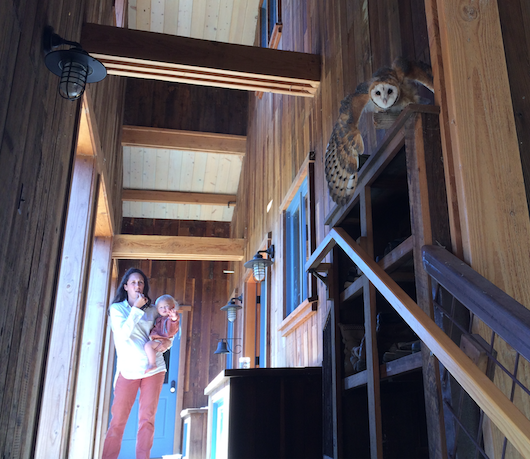Wildlife:
Last Friday, someone found a young barn owl dead on the ground in the walnut orchard. Maybe it was one of the young owls that we had been watching in their first flights from the upstairs porch at Amon and Jenna’s house. These baby owls hatched out last spring in a cubby above the porch and the family made it their home, creating a litter on the floor of their droppings, to such an extent that it was difficult to walk out and watch them without stepping on their pellets. Standing on the porch, we would look up at them, and they would line up and look down at us. We know that most barn owls die young – 70% in their first year – so the babies and their parents have been a source of great delight as we watched and worried over them.
The barn owl is found almost everywhere around the world, and we love that they also live here at Full Belly Farm — their big eyes and beautiful white faces engage our hearts. Barn owls mate for life, so we feel we can get to know the families as the females incubate the young and the males make sure everyone is fed.
The barn owl that died could also have hatched in one of the owl boxes that we have on the farm. The owl boxes are our way of encouraging owls to make their homes here and hunt rodent populations that might explode without this quiet and efficient nocturnal predator.
The owls are only one of the birds that we love on the farm. A researcher from the University of Washington did a one day bird survey in early summer last year and reported back that she saw “a lot of really cool birds”, 43 species in all. She mentioned that she did get to see a barn owl flying over the fields at dusk.

On the same morning that we found the barn owl, our campers found another nocturnal predator, a young rattlesnake curled up next to some towels and backpacks near their picnic table. People’s fear of snakes often means that they mistake a gopher snake or kingsnake for a rattlesnake, so it is worth checking when a rattlesnake is reported. While many people would kill a rattlesnake if they found it on their farm, we believe that rattlesnakes are a beneficial part of the ecosystem, once removed from places frequented by humans. Rattlesnakes have territories, but can often survive if they are moved, which is what I do when I find one on the farm. I like to move rattlesnakes up our canyon into wild places without trails or houses, praying that they will like whatever new home I choose for them.
Driving the perimeter of the farm, that same day, I saw the supervisor of our tomato crew driving a quad around the tomato field, making noise and commotion. As I turned the corner I saw several deer bounding out of the field towards the creek. We have invested a lot of money in deer fencing, both permanent and movable, and we fence in many of our fields to prevent the deer from getting in and disturbing the vegetables. Our crews don’t want the deer to get comfortable hanging out in our fields, and they chase them away when they see them, but Full Belly is next to Cache Creek and a lot of wild lands, so we are under constant pressure from deer, and when the grass is dry in the hills, the deer are hungry for our crops.
That same evening, sitting outside on my porch at dusk, I heard the familiar squeaking and chirping of bats. We have a lot of bats here — some of them live in the palm tree fronds, others live in the lamp shades on my porch. We have discouraged them from living around our packing sheds and barns, but we know that their diet consists of beetles moths and many insects that are pests on the farm, so we don’t want them to disappear entirely. We enjoy watching flocks of bats at dusk flitting around and catching mosquitos.
The scientists say that we are in the midst of the 6th mass extinction, this time almost entirely caused by humans. On the farm, with coyotes and bobcats eating our chickens, bald eagles soaring overhead and sightings of fox and mountain lion not entirely unusual, we have a sense of wildlife on the farm that is wondrous at the same time as it is commonplace. We are surrounded by wild lands, and that is one of the reasons that the Capay Valley is very special. Our farm tries to create a home for pollinators and other wildlife, which means also that we face a constant challenge of living and farming in the presence of Nature.
—Judith Redmond

